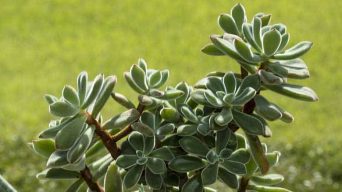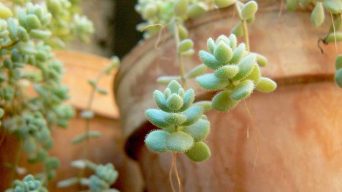Succulents are an interesting type of plant that is both beautiful and easy to take care of! They come in all sorts of shapes, sizes, and colors.
These hardy, low-maintenance plants can be grown in many different ways!
One method of growing succulents is to start from seeds. This can be a fun and rewarding experience, but it does require a bit of patience.
If you’re interested in learning how to grow succulents from seeds, this article will help get you started.
Pros and Cons of Growing Succulents From Seeds
Succulents can be grown in many different ways. If you have a green thumb or are just looking to try something new, growing succulents from seeds may be the right option for your needs.
There are many different pros and cons of this process that should be considered before beginning.
Pros
Some of the pros of growing succulents from seeds include:
- The opportunity to grow a new, unique type of succulent that you may not be able to find in your local stores.
- You will have the satisfaction of knowing how it was created and having complete control over its environment during growth.
- It is usually inexpensive and can save you money.
- It can be done at any time of year.
- Growing succulents from seeds is a great way to introduce your children to gardening and nature.
- You can grow an entire garden of the same succulent.
- You’ll have a better understanding of how to care for these plants once they mature.
Cons
Some of the cons of growing succulents from seeds include:
- It can be a slow process, taking up to several months for the seedlings to reach a size where they can be transplanted.
- There is a greater chance of failure when propagating succulents from seeds than when purchasing them pre-grown.
- It can be more labor-intensive than other methods of growing succulents.
- You will need to provide more care and maintenance during the growing process.
- It can be difficult to transplant succulents grown from seeds because it is hard for them to adjust after being moved around so much when they were still young.
- The succulents may not turn out exactly how you wanted them to.
- It requires a greater time commitment than other methods used to propagate succulents, such as from leaf and stem cuttings.
How to Grow Succulents from Seeds: A Step-by-Step Guide
If you’re ready to try growing your own succulents from seeds, then keep reading for a few simple steps that will help get you started.
1) Find the Right Kind of Seeds
The first step in learning how to grow succulents from seeds is finding the right kind of seeds. There are many online retailers that sell a large variety of seeds from different succulents.
It is up to you which type of succulents you would like to grow, but it’s best to choose one that will be appropriate for the space where you plan on growing them and your level of gardening experience.
Different succulents have different requirements, so it’s essential to research before choosing a type.
Succulent seeds must be fresh, and it’s best to choose organic seeds whenever possible.
Many different types of succulents can be grown from seed.
Some of the most popular types of succulents that can be grown from seed include:
- Aloe
- Echeveria
- Haworthia
- Pachyphytum
- Sansevierias
- Sempervivums
If you’re unsure about which type of succulents to choose, ask a local store where you can buy succulents or an online retailer for advice.
2) Find a Suitable Container
Once you have your seeds, the next step is to find a suitable container. This could be anything from a plastic seed tray to an old yogurt container.
The most important thing is that the container has drainage holes so that the soil can properly dry out between watering.
If you are using a pot, it’s best to choose one that is slightly larger than the succulent plant you plan on planting to allow for enough room to grow.
It’s also best to choose an opaque pot, as this will protect the seedlings from too much light exposure.
If you’re using a planting tray, make sure the depth of the soil is at least twice the height of the seed.
The container you choose will depend on your individual preferences and the amount of available space.
3) Choose a Suitable Soil
The next step is to choose the soil that will be best for planting succulent seeds.
There are many different types of succulent soils available, but it’s best to go with a soil specifically made for cactus and succulents.
The soil should be light and well-draining.
It’s important to avoid using soil that is too dense or has a high percentage of organic material, as this can lead to mold growth.
You can either mix your own succulent soil or purchase a pre-made blend from a garden center or online retailer.
If you’re mixing your own soil, it’s best to use a 50/50 blend of potting soil and sand.
The potting mix should be free of additives such as fertilizer or other chemicals that could damage the seedlings.
You can sterilize the soil by heating it in the oven at 300 degrees Fahrenheit for 30 minutes.
4) Plant Succulent Seeds
Once you have your succulents seeds and soil, it’s time to get planting.
The best way to do this is by following the simple steps below:
- Fill your container with soil up to about an inch from the top.
- Water the soil until it is moist but not soggy and let it drain.
- Sprinkle the seeds over the soil, spacing them out evenly.
- Cover the container with a plastic wrap or glass lid to create a greenhouse effect and keep the moisture in.
- Place the container in a warm area with indirect sunlight.
- Keep the soil moist by watering it every day or two.
Seeds may take anywhere from a few days to a few weeks to germinate, so be patient.
5) Care and Maintenance
Once you have planted your seeds, the next step in learning how to grow succulents from seed is caring for and maintaining them.
Humidity
As soon as they sprout, it’s important to remove the glass or plastic covering to allow proper air circulation and avoid excess humidity.
If you notice mold growing in your container or on top of the soil, it could indicate that there isn’t enough air circulation and humidity is too high.
This can lead to fungal infections, which will kill both seedlings and established succulents.
If this happens, remove the infected plants immediately to prevent further growth.
Be sure to provide enough airflow in your container to prevent mold and fungus growth.
Water
At first, it’s important to keep the soil moist at all times, but once they have germinated, you will need to reduce the amount of water you give them gradually.
While they develop their roots, succulents need more water, but they will need less as they mature and become established.
Once their roots are fully developed, you can water them only when the top inch of soil feels dry to the touch.
Overwatering is one of the most common mistakes made by succulent growers and can quickly kill your plants.
Make sure to observe your plants regularly and adjust their watering schedule accordingly.
Succulents also prefer to be watered in the early morning or evening when the temperatures are cooler to prevent any chance of sunburn.
Light and Temperature
It’s important to keep the succulent seedlings in an area that receives at least six hours of bright light. However, it’s best to avoid direct sunlight for the first few months.
The seedlings will need to be gradually exposed to stronger levels of sunlight as they become older and develop their roots more.
If your seedlings are getting too much direct sunlight, you can move them to a place with bright, indirect light. The best place for succulents is in a south- or west-facing window where they will get plenty of light but not too much heat.
It’s also essential to keep the succulents in a cool area, preferably between 50 and 70 degrees Fahrenheit.
Make sure to keep an eye on the temperature in your growing area and adjust it accordingly.
6) Repotting Succulent Seedlings
Once your succulents have developed their roots and are between two and four inches tall, they can be repotted.
Use a pot that is just large enough to hold the plants comfortably, and make sure to use a soil mix specifically for succulents.
Be very careful when repotting not to damage the delicate roots.
After repotting, water the succulents sparingly and only when the soil is dry to the touch, and keep them in a warm, sunny spot until they have re-established themselves.
Most succulents grow quickly once they are well-established in their pots and require repotting every one or two years whenever new growth begins to appear at the edges of the pot.
By following these simple tips, you can grow your succulents from seeda and have a beautiful, healthy succulent garden in no time!
How Long Does It Take To Grow Succulent Plants From Seeds
The amount of time it takes to grow succulent plants from seeds can vary depending on the type of plant, the growing conditions, and other factors.
In general, it can take anywhere from a few days to a few weeks to germinate succulent seeds.
Once the seeds have germinated, it can take several months to a year for the plants to mature and reach their full size.
With proper care, your succulent plants can live for many years and continue to produce new growth.
Final Thoughts
If you’re looking for a way to add some variety to your garden or just want to get into the gardening hobby, consider growing succulents from seeds.
It can be a slow process, but it’s worth it in the end!
Despite the few drawbacks, growing succulent plants from seeds is a great way to get into the gardening hobby or add variety to your succulents collection.
With a little bit of effort and patience, you can create an amazing garden full of beautiful succulents.







